OPERATIONS WITH DECIMALS
Subscribe to our ▶️ YouTube channel 🔴 for the latest videos, updates, and tips.
We can not imagine the subject Math without the term 'Decimal'. Because, we solve many problems with it. So, we must be aware of the operations which we often do with decimals.
Let us explore the following operations with decimals.
(i) Addition
(ii) Subtraction
(iii) Multiplication
(iv) Division
Adding Decimals
Let us see, how to add the decimals 0.24 and 0.15.
Observe the figure given below.
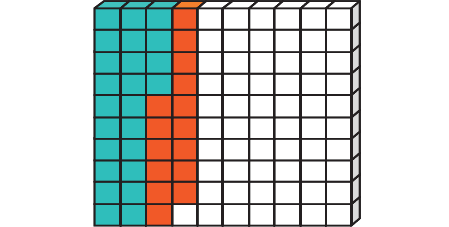
0.24 and 0.15 are shaded in two different colors. Now the sum of 0.24 and 0.15 is 0.39
3 tenths and 9 hundredths
Method 1 :
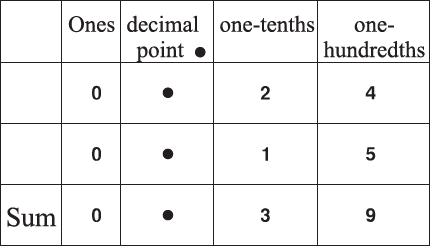
Therefore,
0.24 + 0.15 = 0.39
Method 2 :

Therefore,
0.24 + 0.15 = 0.39
Note :
In both the methods, arrange the decimal numbers according to the place values and add them.
Add : 0.75 and 0.5

In the above addition of decimals, 0.2 is taken as 0.20, as the first decimal number has two digits on the right side of the decimal point.
Subtracting Decimals
Let us see, how to subtract the decimal 0.14 from 0.25.
Observe the figure given below.
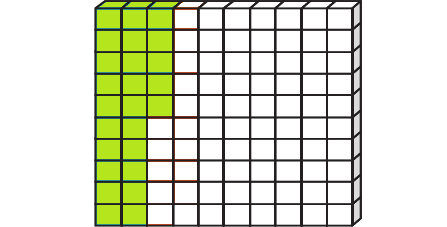
0.25 is shaded in green color.
Since, we are subtracting 0.14 from 0.25, let us shade 0.14 in red color in some of the green colored boxes.
Then, we have
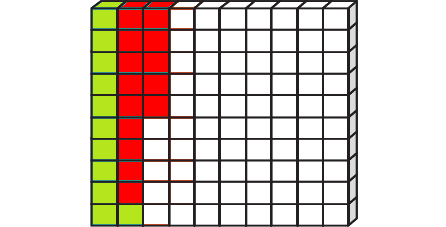
To get the result of 0.25 - 0.14, count the number of green colored boxes. That is 0.11.
Method 1 :
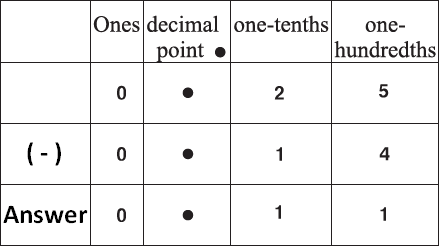
Therefore,
0.25 - 0.14 = 0.11
Method 2 :

Therefore,
0.25 - 0.14 = 0.11
Note :
In both the methods, arrange the decimal numbers according to the place values and subtract them.
Multiplying Decimals
Let us see, how to multiply 1.5 and 4.3.
Multiplying 15 and 43, we get 645.
Both, in 1.5 and 4.3, there is 1 digit to the right of the decimal point. So, count 2 digits from the right and put a decimal point.
So, we get 1.5 x 4.3 = 6.45.
While multiplying 1.43 and 2.1, you will first multiply 143 and 21. For placing the decimal in the product obtained, you will count 2 + 1 = 3 digits starting from the right most digit.
Thus 1.43 × 2.1 = 3.003.
Dividing Decimals
Dividing Decimals by Whole Numbers :
Method 1 :
Find 4.2 ÷ 3.
Solution :
Write the decimal number 4.2 as a fraction with multiples of 10.
Since there is only one digit after the decimal in 4.2, we can write 4.2 as 42/10.
(If there are two digits after the decimal, we have to take 100 as denominator)
Now, we have to divide 42/10 by 3 as given below.
4.2 ÷ 3 = 42/10 ÷ 3
= 42/10 x 1/3
= 14/10
= 1.4
Method 2 :
Find 18.5 ÷ 5.
Solution :
First, let us find 185 ÷ 5. We get 37.
There is one digit to the right of the decimal point in 18.5.
Place the decimal point in 37 such that there would be one digit to its right.
Then, we will get 3.7.
Dividing Decimal by Another Decimal :
Find 17.6 ÷ 0.4.
Solution :
First, let us write both the decimals 17.6 and 0.4 as 176/10 and 4/10.
Now, we can divide 176/10 by 4/10 as given below.
17.6 ÷ 0.4 = 176/10 ÷ 4/10
= 176/10 x 10/4
= 44
Problem 1 :
What will be the perimeter of a rectangle whose length is 2 m and breadth is 1.5 m?
Solution :
Perimeter of the rectangle = 2(length + width)
Length = 2 m and width = 1.5 m
= 2(2 + 1.5)
= 2(3.5)
= 7 m
So, the perimeter of the rectangle is 7 m.
Problem 2 :
Gorang purchased 2 kg 280 g apples, 3kg 375g bananas, 225g grapes and 5kg 385g oranges. Find the total weight of the fruits purchased by Gorang in kg.
Solution :
Weight of apples = 2 kg 280 g
Weight of bananas = 375 g
Weight of grapes = 225 g
Weight of oranges = 5 kg 385 g
Total weight = (2 + 5) kg (280 + 375 + 225 + 385) grams
= 7 kg 1265
= 7 kg + 1000 grams + 265 grams
1000 grams = 1 kg
= (7 + 1) kg 265 grams
= 8 kg 265 grams
Problem 3 :
0. 023 lies between
(A) 0.2 and 0.3 (B) 0.02 and 0.03
(C) 0.03 and 0.029 (D) 0.026 and 0.024
Solution :
Option A :
0.2 and 0.3
0.20 and 0.30
So, 0.203 is not in between them
Option B :
0.020, 0.021, 0.022, 0.023, 0.024, 0.025, 0.026, 0.027, 0.028, 0.029 and 0.030
So, 0.203 is in between them. Option B is correct.
Problem 4 :
0.07 + 0.008 is equal to
(A) 0.15 (B) 0.015 (C) 0.078 (D) 0.78
Solution :
= 0.07 + 0.008
= 0.015
So, option B is correct.
Problem 5 :
Which of the following decimals is the greatest?
(A) 0.182 (B) 0.0925 (C) 0.29 (D) 0.038
Solution :
0.29 is the greater of the given numbers.
Problem 6 :
Which of the following decimals is the smallest?
(A) 0.27 (B) 1.5 (C) 0.082 (D) 0.103
Solution :
0.082 is the smallest number of given numbers.
Problem 7 :
13.572 correct to the tenths place is
(A) 10 (B) 13.57 (C) 14.5 (D)13.6
Solution :
13.572
The number at the tenth place is 5, after that we have 7 which is greater than 5. So, we may round the number as 13.6. O
Problem 8 :
15.8 – 6.73 is equal to
(A) 8.07 (B) 9.07 (C) 9.13 (D) 9.25
Solution :
= 15.8 – 6.73
= 9.07
So, option B is correct.
Subscribe to our ▶️ YouTube channel 🔴 for the latest videos, updates, and tips.
Kindly mail your feedback to v4formath@gmail.com
We always appreciate your feedback.
About Us | Contact Us | Privacy Policy
©All rights reserved. onlinemath4all.com
Recent Articles
-
Specifying Units of Measure
Dec 15, 25 07:09 PM
Specifying Units of Measure -
Quantitative Reasoning Questions and Answers
Dec 14, 25 06:42 AM
Quantitative Reasoning Questions and Answers -
Coin Tossing Probability
Dec 13, 25 10:11 AM
Coin Tossing Probability - Concept - Sample Space - Formula - Solved Problems